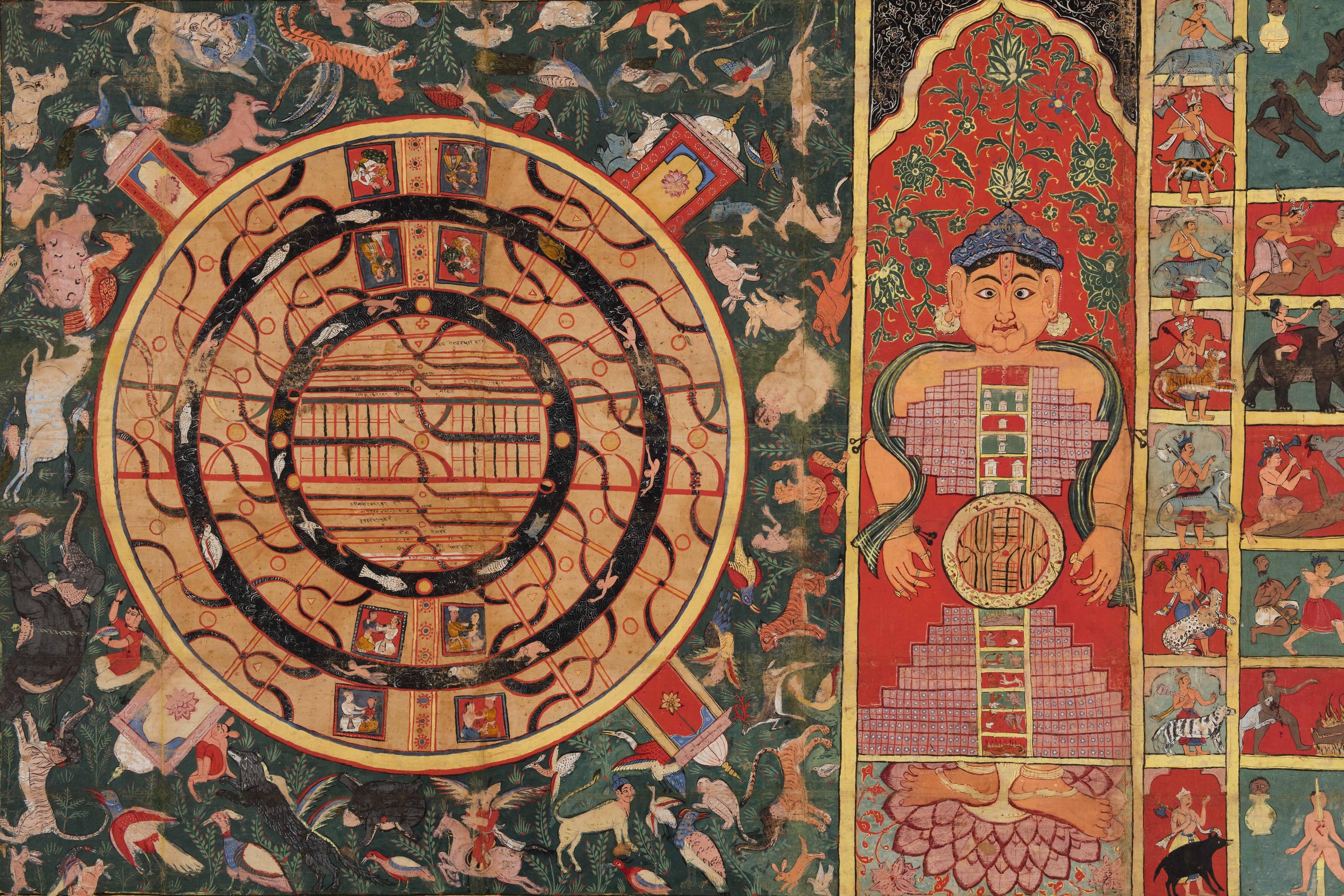In the 1970s and ’80s, an ancient Buddhist technique for accessing the true nature of reality, known as sati, was imported to the West and became rebranded as a stress-reduction technique called ‘mindfulness’. Today, this technique has become a foundational psychological treatment that has spread across the world. It appears in hip wellness studios in France, corporate offices in Australia, and the pages of American medical insurance policies. In Germany, 82 per cent of psychotherapists are now using mindfulness in their work – a testament to its success and value. The global spread of the technique has helped millions ease their mental turmoil and find a little solace.
But recent studies have started to question the widely reported efficacy of mindfulness. Such findings follow growing concerns about the ways that the practice has become a one-size-fits-all approach to complex modern issues. It seems that something crucial is missing in the way the technique is understood and used. But what?
Considering the original context of mindfulness, this comes as no surprise: sati involved much more than being aware of the present moment and regulating how we think and feel. For early Buddhists, it was a holistic practice, deeply intertwined with memory, ethical discernment, and an understanding of the self and the world. Sati helped practitioners learn to see the impermanent and interconnected nature of all phenomena: an ultimate realisation that would reduce their attachment to the transient things of this world.
On the surface, the two approaches appear opposed. Mindfulness is backed by the rigours of evidence-based scientific research; sati is supported by the enduring insights of Buddhist tradition. But they may not be so incompatible. Recent insights from complexity theory seem to hint that some of the wisdom of Eastern philosophy, the conceptual foundations of sati, may have scientific grounding. If this is true, could sati provide what mindfulness lacks? Could this ancient practice offer a way to move beyond ‘stress-reduction’?
Sometime during the 5th century BCE in India, the Buddha developed a ‘theory of everything’, a system of ideas and practices that would give his practitioners a way of attaining lasting freedom from the dissatisfactions of life. This system incorporated philosophy, science, ethics, physical and mental practices, guidance on communal living, relationships and environmentalism. Sati, a Pali word originally translated as ‘memory’ or ‘remembrance’, was the name given to the method that brought the system together. It involved actively recalling the Buddha’s teachings through the practice of observing one’s body and mind.
Eventually, practitioners would learn to become aware of their intentions, encountering joy, compassion and wisdom along the way. And this, in turn, would help them cultivate ethical discernment, and integrate insight (vipassana) with meditative absorption (samadhi). In ancient Buddhist texts, like the Satipaṭṭhāna Sutta, which was compiled more than 2,000 years ago, sati is described as a path – involving the careful observation of emotions, thoughts and physical sensations – that can allow a practitioner to directly experience the truths of impermanence (anicca), suffering (dukkha) and no-self (anatta). Upon realising the nature of reality, they would be free from all the dissatisfactions of life: they would reach nirvana.
Kabat-Zinn’s approach made mindfulness an expression of Western values
Figures like Jon Kabat-Zinn, an American professor of medicine, played a pivotal role in distilling sati into accessible psychological frameworks like Mindfulness-Based Stress Reduction (MBSR), which remains popular today. In the 1970s, inspired by Buddhist teachers like Thich Nhat Hanh and Seungsahn, Kabat-Zinn began to recognise how the profound benefits of sati could be made accessible to Western audiences. This was no easy feat. The challenge, in his words, involved figuring out:
[H]ow to take the heart of something as meaningful, as sacred if you will, as Buddha-dharma and bring it into the world in a way that doesn’t dilute, profane or distort it, but at the same time is not locked into a culturally and tradition-bound framework that would make it absolutely impenetrable to the vast majority of people, who are nevertheless suffering and might find it extraordinarily useful and liberative.
His solution involved reframing mindfulness as a secular, scientific practice for reducing stress and improving mental health. This opened mindfulness to empirical validation, allowing the practice to gain traction in clinical settings and beyond. However, Kabat-Zinn’s approach also made mindfulness an expression of Western values, such as individual identity and self-improvement. This put the practice in tension with traditional Buddhist teachings on the interconnectedness of reality and the dissolution of the ego-self. Through Kabat-Zinn, mindfulness became a tool for enhancing personal wellbeing and cognitive resilience, rather than a means of, as Buddhist texts describe, ‘waking up from delusion’. Though he believed his adaptation was ‘true to the heart of the Dharma’, others disagreed. To critics, mindfulness was a bad appropriation or, even worse, entirely at odds with Buddhism. Sati was meant to be a technique for transcending the self, not obsessing over it.
Despite the tensions, the new version of mindfulness appeared to be effective. Studies have shown that it can reduce symptoms of anxiety, depression and stress, improve focus and emotional regulation, and foster healthy lifestyle habits, like better sleep. But this is not the full story. Complications are starting to emerge. Recent research has begun to question the efficacy of mindfulness as a benign intervention, revealing that sati’s simplified Western form may be missing something.
For instance, a 2021 study showed that, while mindfulness helps foster prosocial behaviour among those who self-identify as interdependent (ie, who tend to rely on other people), it can decrease prosocial behaviour among the those who are more independent. These results suggest that cultural and philosophical context plays an important role in shaping the effectiveness of mindfulness. At the same time, some of the largest studies and meta-analyses of mindfulness-based interventions in schools have shown either moderate improvements in mental health or none at all. In some cases, mindfulness can even have adverse effects. One review found that up to 25 per cent of participants in shorter mindfulness programmes experienced lingering adverse effects, such as a heightened awareness of distressing thoughts or memories.
It was the only way that mindfulness could fit neatly into clinical and scientific settings around the world
Without a deeper understanding, modern secular mindfulness can become a strange imitation of sati – an empty ritual performed without any awareness of the practice’s underlying mechanisms. Modern techniques might sometimes mimic traditional forms, like sitting in lotus posture or counting breaths, but miss the broader ethical, spiritual and philosophical systems that give these practices their transformative power. For Buddhist practitioners, sati was not something to be taken lightly – without the proper support and theoretical framework. Sometimes, it could even be dangerous. From this perspective, mindfulness can appear stripped of its depth. The richness of sati lies not just in the act of meditation itself, but in its integration with a way of life that emphasises compassion, wisdom and ethical conduct.
For Kabat-Zinn and others, this broader context was shed for good reasons: it was the only way that mindfulness could fit neatly into clinical and scientific settings around the world. However, science has come a long way since the 1970s and ’80s.
The challenges in importing sati to the West stem partly from ‘simple-systems thinking’, the scientific paradigm dominant during the late 20th century. This approach relies on reductionism: breaking down systems into discrete, independent parts to study their behaviour in isolation. It tends to assume a complete understanding of the system under investigation – whether it’s human bodies, social groups or highways – and relies on simple, linear cause-and-effect relationships. In mainstream medicine and psychology, many interventions follow this paradigm by focusing on symptoms rather than underlying causes. Under this model, a suicidal person suffering from depression might be given an antidepressant to ease their pain, without acknowledging or addressing the social, emotional and economic factors that brought about their condition. Mindfulness was translated using a similar way of thinking, which allowed it to fit neatly into clinical trials and Western healthcare systems. However, this left the practice fundamentally divorced from the holistic worldview of traditional Eastern philosophies – it was separated from the rich, interconnected world of sati.
In the 21st century, complexity science has gained momentum as a research field that offers a more nuanced perspective. Unlike simple-systems thinking, complexity science focuses on systems with many interconnected parts whose behaviours emerge from their interactions, often in unintuitive ways. In the Amazon rainforest or the stock exchange, small interventions can ripple unpredictably through the entire ecosystem or economy. Another example is traffic flow: while adding a new lane might seem like a straightforward solution to congestion (a simple-system approach), complexity science reveals how this can trigger feedback loops that worsen traffic in unexpected ways. This was seen in the infamous billion-dollar expansion of California’s Interstate 405, one of the busiest highways in the United States. Increased space on the road invited more people to drive, making congestion worse.
Higher-order patterns arise from interactions among simpler components
Remarkably, complexity science seems to align closely with certain aspects of Eastern philosophy, particularly in the way it conceives of interconnectedness and non-linear causality. For example, the Buddhist concept of dependent origination (pratītyasamutpāda), which describes how all phenomena arise through intricate webs of causes and conditions, is mirrored by the concept of ‘emergence’ in complexity science.
Dependent origination teaches that the seemingly individual ‘self’ – whatever we think of as ‘me’ – is not a fixed or independent entity, but an emergent property of dynamic processes. It arises from the intertwining of sensory experiences, mental formations and consciousness, on which we then hang all our hopes and dreams. This appears to be closely related to the feedback loops and emergent behaviour studied by complexity science, where higher-order patterns arise from interactions among simpler components. Consider the flocking of birds or schooling of fish, where behaviour does not emerge from any single individual’s intention. Instead, the coordinated movement arises from interactions that follow simple rules – each individual adjusts its position based on its neighbours. Similarly, in Buddhism, the ‘self’ arises from the interplay of mental and physical processes, rather than from the guidance of some intrinsic entity or a ‘me’.
This is just one of many possible correspondences between complexity science and Buddhism. Such alignments suggest that recovering the philosophical and esoteric foundations of sati may not only expand and ground modern mindfulness: they might also inform our research into complex systems.
The secular transformation of sati has helped millions, but recent research has revealed the limitations and potential risks of using a ‘simple-system’ approach to mindfulness. As the efficacy of the practice comes into question, its future may appear shaky. What is missing may be the wider framework of sati, an ancient technique for learning to see the impermanent and interconnected nature of all phenomena. Though the philosophies beneath mindfulness and sati appear incompatible, they might be unified.
Responding to the problems of mindfulness does not require us to abandon the modern, Western, scientific rebranding of sati. It also does not require us to dismiss seemingly esoteric concepts from Eastern philosophy, such as the doctrine of no-self. Instead, these concepts may hint at valuable scientific insights, just expressed in a different cultural language. Complexity science offers a promising bridge to translate ancient wisdom traditions into rigorous scientific frameworks. This translation could make mindfulness interventions safer and more effective, and ensure the research on them is more conceptually guided. We are yet to see.
Mindfulness can become more than a tool for ‘stress reduction’. Understood through complexity science, sati offers a way of recovering the lost depths of this modern technique. At a time when mindfulness appears to be on shaky ground, returning to its foundations can open new paths to compassion, wisdom and ethics. This ancient practice might also lead us to appreciate anew, as early practitioners of sati claimed, the exquisitely complex reality of our interconnected and ever-emerging world.








